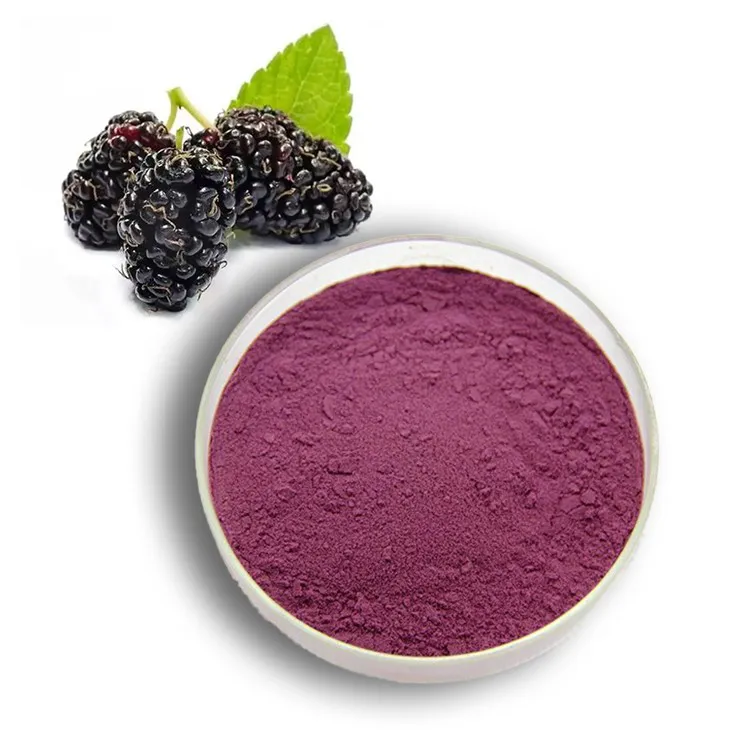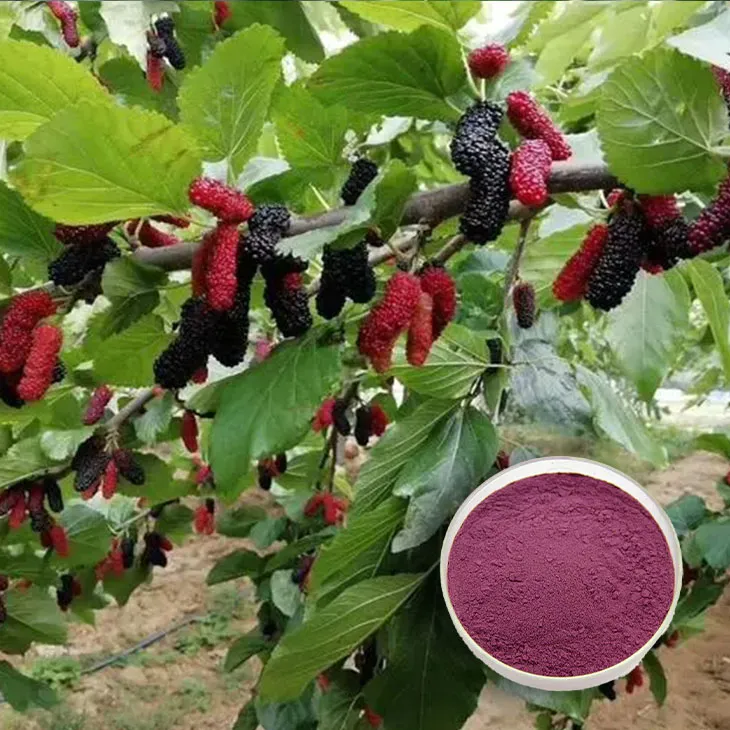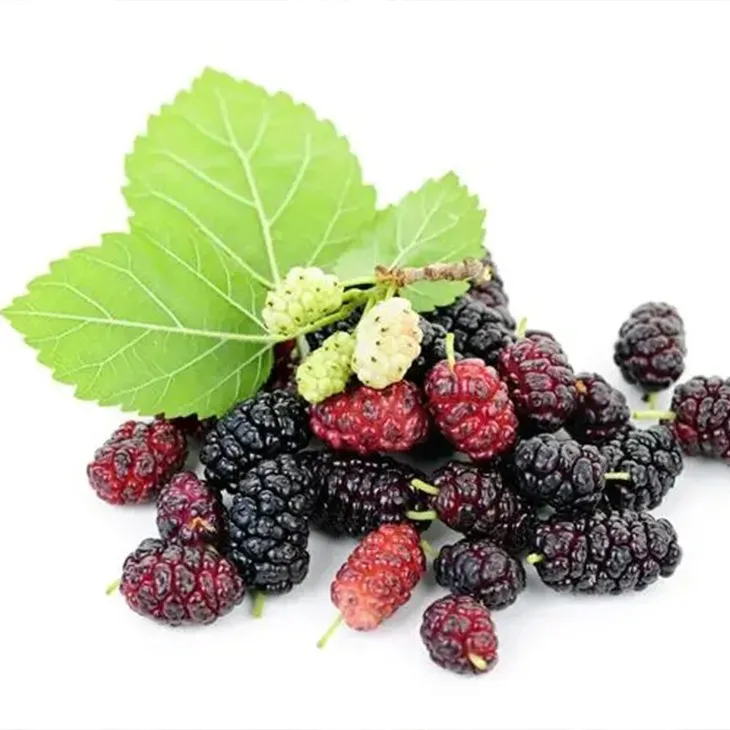- 0086-571-85302990
- sales@greenskybio.com
The flavor of ripe mulberries and natural mulberry extracts.
2024-11-11

1. Introduction
Mulberries, whether in their natural ripe state or as extracts, have been of great interest in various fields. The flavor of ripe mulberries is a complex and delightful combination of sweetness, acidity, and unique fruity notes. On the other hand, natural Mulberry Extracts are concentrated forms that capture certain aspects of the mulberry's properties. Understanding the differences and similarities between them is crucial, especially when considering their applications in food, medicine, and cosmetics.

2. Chemical Compositions
2.1 Ripe Mulberries
Ripe mulberries are rich in various nutrients. They contain sugars such as fructose and glucose, which are responsible for their sweet taste. The presence of organic acids like citric acid and malic acid gives them a slightly tart flavor. Additionally, they are a good source of vitamins, especially vitamin C, and minerals like potassium. Flavonoids, including anthocyanins, are also present in ripe mulberries. These flavonoids not only contribute to the color of the mulberries (ranging from deep purple to red) but also have antioxidant properties.
2.2 Natural Mulberry Extracts
Natural Mulberry Extracts are obtained through various extraction methods. They are often concentrated in certain components. For example, mulberry leaf extracts are rich in 1 - deoxynojirimycin (DNJ), which has potential health benefits related to blood sugar regulation. Mulberry fruit extracts may be concentrated in anthocyanins and other phenolic compounds. These extracts may also contain some of the sugars and acids found in ripe mulberries, but in different proportions. The extraction process can remove some of the water - soluble components and leave behind a more concentrated form of the desired substances.

3. Health - Promoting Properties
3.1 Ripe Mulberries
The antioxidants in ripe mulberries, such as anthocyanins, play a significant role in protecting the body from oxidative stress. Oxidative stress is associated with various diseases, including heart disease and cancer. The vitamins and minerals in mulberries also contribute to overall health. For example, vitamin C is important for the immune system, and potassium is essential for proper heart and muscle function. The fiber content in mulberries can aid in digestion and help maintain a healthy digestive tract.
3.2 Natural Mulberry Extracts
As mentioned before, mulberry leaf extracts with DNJ have been studied for their potential in blood sugar control. They may inhibit the absorption of carbohydrates in the intestine, thus helping to regulate blood glucose levels. Mulberry fruit extracts, due to their high concentration of anthocyanins, may have stronger antioxidant effects compared to whole mulberries. These extracts are also being investigated for their potential anti - inflammatory properties, which could be beneficial in treating conditions such as arthritis.

4. Applications in Food
4.1 Ripe Mulberries
Ripe mulberries can be eaten fresh, which provides a direct experience of their unique flavor. They can also be used in making jams, jellies, and preserves. In baking, mulberries can be added to muffins, pies, and cakes, adding both flavor and a pop of color. Mulberry juice is another popular form, which can be consumed on its own or used as an ingredient in cocktails or smoothies. The natural sweetness and acidity of mulberries make them a versatile ingredient in the food industry.
- For example, in a mulberry - raspberry jam, the mulberries add a deeper, more complex flavor compared to using only raspberries.
- When added to a smoothie, they can enhance the overall taste and provide additional nutrients.
4.2 Natural Mulberry Extracts
Natural mulberry extracts are used in the food industry mainly as natural colorants and flavor enhancers. The anthocyanins in the extracts can provide a natural purple - red color to food products, such as candies, yogurts, and ice creams. They can also be used to enhance the flavor of products, especially those that aim to have a fruity or berry - like taste. In some cases, mulberry extracts are added to functional foods, such as those designed for blood sugar management, to take advantage of their potential health - promoting properties.
- For instance, a natural berry - flavored yogurt may use mulberry extract to intensify the berry flavor.
- In a line of "healthy" candies, mulberry extract can be added not only for color but also for its potential antioxidant benefits.
5. Applications in Medicine
5.1 Ripe Mulberries
While ripe mulberries are not typically used as a sole medicinal treatment, their nutritional content can contribute to overall health, which in turn may have a positive impact on certain medical conditions. For example, the antioxidants in mulberries may help reduce the risk of chronic diseases. Their fiber content can also be beneficial for patients with digestive problems. However, more research is needed to establish specific medicinal uses for ripe mulberries.
5.2 Natural Mulberry Extracts
As mentioned earlier, mulberry leaf extracts with DNJ have potential in diabetes management. In traditional medicine, mulberry extracts have been used for treating various ailments. Modern research is exploring their potential in other areas as well. For example, some studies are looking into the anti - cancer properties of mulberry extracts, especially those rich in phenolic compounds. They may be able to inhibit the growth of cancer cells or enhance the effectiveness of chemotherapy drugs.
6. Applications in Cosmetics
6.1 Ripe Mulberries
The antioxidants in ripe mulberries can be beneficial for skin health. They can help protect the skin from damage caused by free radicals, which are associated with premature aging. However, using ripe mulberries directly in cosmetics may be challenging due to their perishable nature. Some small - scale cosmetic products may use fresh mulberry pulp or juice, but these are not as common as products using extracts.
6.2 Natural Mulberry Extracts
Natural mulberry extracts are widely used in cosmetics. The anthocyanins can be used for their antioxidant and anti - inflammatory properties. They can be added to creams, lotions, and serums to improve skin texture, reduce wrinkles, and soothe irritated skin. Mulberry extracts are also being studied for their potential in hair care products. They may help strengthen hair follicles and improve hair growth.
7. Conclusion
In conclusion, the flavor of ripe mulberries and natural mulberry extracts have both similarities and differences. Their chemical compositions are related, but the extraction process of the latter leads to a more concentrated form with different proportions of components. In terms of health - promoting properties, both have antioxidant and potentially other beneficial effects, but the extracts may be more targeted in certain areas. In food, medicine, and cosmetics, they each find their own applications, with ripe mulberries being more commonly used in fresh and processed food products, and natural mulberry extracts being more utilized in areas where concentration and specific properties are desired. Overall, further research on both ripe mulberries and their extracts will continue to uncover new potential uses and benefits.
FAQ:
1. What are the main chemical components in the flavor of ripe mulberries?
The flavor of ripe mulberries is mainly composed of various organic compounds. It contains sugars like fructose and glucose which contribute to its sweet taste. There are also organic acids such as citric acid and malic acid that add a touch of tartness. Additionally, it has volatile compounds like esters, aldehydes, and terpenes which are responsible for its characteristic aroma.
2. How is the chemical composition of natural mulberry extracts different?
Natural mulberry extracts typically contain a concentrated amount of certain bioactive compounds. They may have a higher proportion of phenolic compounds such as flavonoids (e.g., rutin and Quercetin) compared to the whole ripe mulberries. These extracts also might include polysaccharides which have different functions. Some of the volatile compounds present in the whole fruit may be lost during the extraction process, resulting in a different chemical profile.
3. What are the health - promoting properties of the flavor of ripe mulberries?
The flavor of ripe mulberries comes from components that offer various health benefits. The sugars provide energy. The antioxidants present, such as vitamins C and E, help in fighting oxidative stress. The fiber in mulberries aids in digestion and can help regulate blood sugar levels to some extent. Also, the anthocyanins which contribute to the color and flavor are known for their anti - inflammatory properties.
4. What unique health - promoting properties do natural mulberry extracts have?
Natural mulberry extracts are rich in bioactive compounds that have specific health - promoting properties. The high concentration of flavonoids has been associated with cardiovascular health, as they can help reduce cholesterol levels. Some of the phenolic compounds in the extracts have shown potential in anti - cancer research. The polysaccharides may boost the immune system, and they are also being studied for their role in anti - aging.
5. How are ripe mulberries used in the food industry?
Ripe mulberries are used in a variety of ways in the food industry. They can be eaten fresh, added to fruit salads, or used in making jams, jellies, and preserves. They are also used in baking, for example, in pies and muffins. In some cases, they are used to make mulberry wine or vinegar.
6. How are natural mulberry extracts utilized in the fields of medicine and cosmetics?
In the field of medicine, natural mulberry extracts are being studied for their potential in treating various diseases. For example, they may be used in the development of drugs for diabetes management due to their blood - sugar - regulating properties. In cosmetics, the antioxidant - rich extracts are used in skincare products. They can help protect the skin from free - radical damage, reduce wrinkles, and improve skin elasticity.
Related literature
- Analysis of the Chemical Composition of Ripe Mulberries"
- "Health Benefits of Natural Mulberry Extracts: A Review"
- "Utilization of Mulberries in the Food Industry"
- "The Role of Mulberry Extracts in Medicine"
- "Mulberry Extracts in Cosmetics: Properties and Applications"
- ▶ Hesperidin
- ▶ Citrus Bioflavonoids
- ▶ Plant Extract
- ▶ lycopene
- ▶ Diosmin
- ▶ Grape seed extract
- ▶ Sea buckthorn Juice Powder
- ▶ Fruit Juice Powder
- ▶ Hops Extract
- ▶ Artichoke Extract
- ▶ Mushroom extract
- ▶ Astaxanthin
- ▶ Green Tea Extract
- ▶ Curcumin
- ▶ Horse Chestnut Extract
- ▶ Other Product
- ▶ Boswellia Serrata Extract
- ▶ Resveratrol
- ▶ Marigold Extract
- ▶ Grape Leaf Extract
- ▶ New Product
- ▶ Aminolevulinic acid
- ▶ Cranberry Extract
- ▶ Red Yeast Rice
- ▶ Red Wine Extract
-
Black Rice Extract
2024-11-11
-
Angelica sinensis extract
2024-11-11
-
Beetroot juice Powder
2024-11-11
-
Ivy Extract
2024-11-11
-
Boswellia Serrata Extract
2024-11-11
-
Rosemary extract
2024-11-11
-
Saw Palmetto Extract
2024-11-11
-
Nutmeg Extract
2024-11-11
-
Epimedium extract powder
2024-11-11
-
Sugarcane Extract
2024-11-11





















